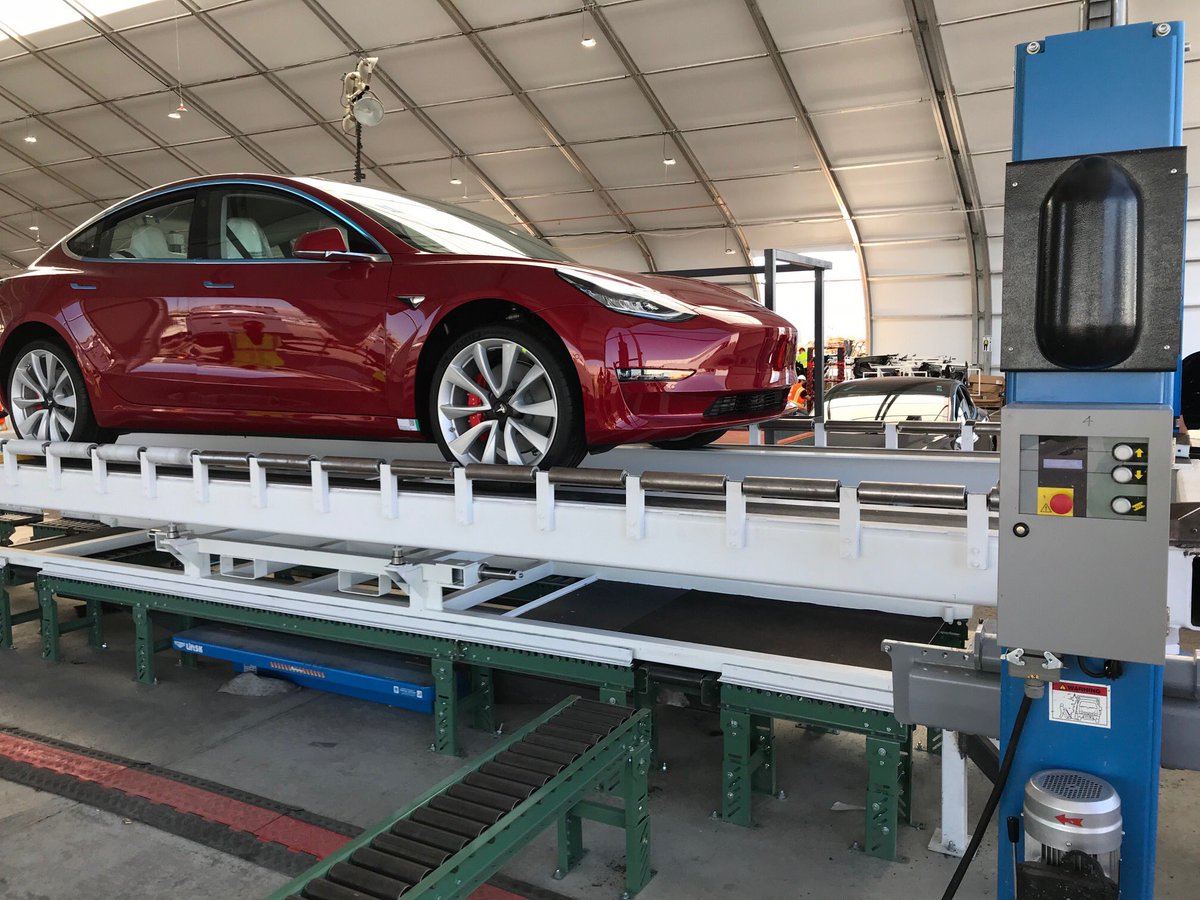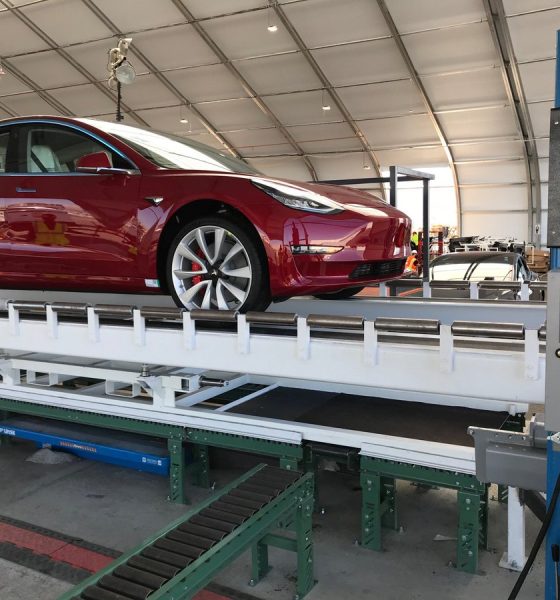

Investor's Corner
Elon Musk explains why Tesla built a tent for its new Model 3 assembly line
Tesla CEO Elon Musk has taken to Twitter to discuss why the company decided to set up its newest assembly line for the Model 3 inside a massive tent on the grounds of the Fremont factory. According to Musk, the tent was the result of time constraints, as the company is attempting to hit a pace equivalent to 5,000 Model 3 per week by the end of Q2 2018.
Needed another general assembly line to reach 5k/week Model 3 production. A new building was impossible, so we built a giant tent in 2 weeks. Tesla team kfa!! Gah, love them so much ♥️🚘💫
— Elon Musk (@elonmusk) June 19, 2018
What’s even more remarkable was that some of the materials used by the Tesla team in constructing the giant tent were scraps the company had in its warehouses. In a later tweet, Musk noted that the tent-housed new line is actually “way better” than Tesla’s other general assembly line, which cost the company hundreds of millions of dollars.
Overall, Musk appears to be optimistic about Fremont’s giant tent. When asked by one of his Twitter followers if the structure is just a temporary solution to achieve the company’s goal of building 5,000 Model 3 per week, Musk stated that he was not sure if Tesla actually needs a building, considering that the tent was already “pretty sweet.” Musk also mentioned that the Tesla Grohmann line is now in place and operating at Gigafactory 1.
Not sure we actually need a building. This tent is pretty sweet. Tesla Grohmann line is in place at Giga & spooling up now. They super kicked ass too. Heiliger Strohsack!
— Elon Musk (@elonmusk) June 19, 2018
As for worries that Tesla’s workers at the giant tent in Fremont will be uncomfortable, Musk noted that the massive outdoor structure had a view of the surrounding Bay Area mountains and is actually more comfortable than the buildings of the factory. The Tesla CEO further stated that a media tour would probably be held next week, in order to give recognition to the Tesla team, which has pulled off something “miraculous.”
Tesla’s massive tent in Fremont was first spotted by Tesla enthusiasts earlier this month through online services such as Building Tesla. As could be seen in satellite photos of the site, Tesla’s new Model 3 assembly line was around 900 feet in length as of mid-June. Speculations were abounding then among Tesla enthusiasts about what the structure would be used for.
These speculations were addressed this past weekend, when Elon Musk shared a picture featuring the first Model 3 Performance Dual Motor being rolled off the company’s newest assembly line. As noticed by Tesla supporters and critics alike, the vehicle seemed to have been assembled inside a massive tent.
Tesla’s new assembly line bodes well for the company’s chances of hitting its production goals for the Model 3 this quarter. Since the company began manufacturing the compact electric car, it has so far missed its production targets. During Q1 2018, however, Tesla ended the quarter just short of a few hundred Model 3. Since then, the company has doubled down on its efforts to scale the production of the vehicle. New assembly lines were installed, robots and equipment were flown in from Europe, bottlenecks were addressed, record numbers of new Model 3 VINs were registered, and orders for the Model 3’s next two variants — the Performance and Dual Motor AWD — were opened for reservation holders. As the month ends, Tesla is closer than it has ever gone in attaining its ever-elusive goal of producing 5,000 Model 3 per week.

Investor's Corner
Tesla stock closes at all-time high on heels of Robotaxi progress

Tesla stock (NASDAQ: TSLA) closed at an all-time high on Tuesday, jumping over 3 percent during the day and finishing at $489.88.
The price beats the previous record close, which was $479.86.
Shares have had a crazy year, dipping more than 40 percent from the start of the year. The stock then started to recover once again around late April, when its price started to climb back up from the low $200 level.
This week, Tesla started to climb toward its highest levels ever, as it was revealed on Sunday that the company was testing driverless Robotaxis in Austin. The spike in value pushed the company’s valuation to $1.63 trillion.
Tesla Robotaxi goes driverless as Musk confirms Safety Monitor removal testing
It is the seventh-most valuable company on the market currently, trailing Nvidia, Apple, Alphabet (Google), Microsoft, Amazon, and Meta.
Shares closed up $14.57 today, up over 3 percent.
The stock has gone through a lot this year, as previously mentioned. Shares tumbled in Q1 due to CEO Elon Musk’s involvement with the Department of Government Efficiency (DOGE), which pulled his attention away from his companies and left a major overhang on their valuations.
However, things started to rebound halfway through the year, and as the government started to phase out the $7,500 tax credit, demand spiked as consumers tried to take advantage of it.
Q3 deliveries were the highest in company history, and Tesla responded to the loss of the tax credit with the launch of the Model 3 and Model Y Standard.
Additionally, analysts have announced high expectations this week for the company on Wall Street as Robotaxi continues to be the focus. With autonomy within Tesla’s sights, things are moving in the direction of Robotaxi being a major catalyst for growth on the Street in the coming year.
Elon Musk
Tesla needs to come through on this one Robotaxi metric, analyst says
“We think the key focus from here will be how fast Tesla can scale driverless operations (including if Tesla’s approach to software/hardware allows it to scale significantly faster than competitors, as the company has argued), and on profitability.”

Tesla needs to come through on this one Robotaxi metric, Mark Delaney of Goldman Sachs says.
Tesla is in the process of rolling out its Robotaxi platform to areas outside of Austin and the California Bay Area. It has plans to launch in five additional cities, including Houston, Dallas, Miami, Las Vegas, and Phoenix.
However, the company’s expansion is not what the focus needs to be, according to Delaney. It’s the speed of deployment.
The analyst said:
“We think the key focus from here will be how fast Tesla can scale driverless operations (including if Tesla’s approach to software/hardware allows it to scale significantly faster than competitors, as the company has argued), and on profitability.”
Profitability will come as the Robotaxi fleet expands. Making that money will be dependent on when Tesla can initiate rides in more areas, giving more customers access to the program.
There are some additional things that the company needs to make happen ahead of the major Robotaxi expansion, one of those things is launching driverless rides in Austin, the first city in which it launched the program.
This week, Tesla started testing driverless Robotaxi rides in Austin, as two different Model Y units were spotted with no occupants, a huge step in the company’s plans for the ride-sharing platform.
Tesla Robotaxi goes driverless as Musk confirms Safety Monitor removal testing
CEO Elon Musk has been hoping to remove Safety Monitors from Robotaxis in Austin for several months, first mentioning the plan to have them out by the end of 2025 in September. He confirmed on Sunday that Tesla had officially removed vehicle occupants and started testing truly unsupervised rides.
Although Safety Monitors in Austin have been sitting in the passenger’s seat, they have still had the ability to override things in case of an emergency. After all, the ultimate goal was safety and avoiding any accidents or injuries.
Goldman Sachs reiterated its ‘Neutral’ rating and its $400 price target. Delaney said, “Tesla is making progress with its autonomous technology,” and recent developments make it evident that this is true.
Investor's Corner
Tesla gets bold Robotaxi prediction from Wall Street firm
Last week, Andrew Percoco took over Tesla analysis for Morgan Stanley from Adam Jonas, who covered the stock for years. Percoco seems to be less optimistic and bullish on Tesla shares, while still being fair and balanced in his analysis.

Tesla (NASDAQ: TSLA) received a bold Robotaxi prediction from Morgan Stanley, which anticipates a dramatic increase in the size of the company’s autonomous ride-hailing suite in the coming years.
Last week, Andrew Percoco took over Tesla analysis for Morgan Stanley from Adam Jonas, who covered the stock for years. Percoco seems to be less optimistic and bullish on Tesla shares, while still being fair and balanced in his analysis.
Percoco dug into the Robotaxi fleet and its expansion in the coming years in his latest note, released on Tuesday. The firm expects Tesla to increase the Robotaxi fleet size to 1,000 vehicles in 2026. However, that’s small-scale compared to what they expect from Tesla in a decade.
Tesla expands Robotaxi app access once again, this time on a global scale
By 2035, Morgan Stanley believes there will be one million Robotaxis on the road across multiple cities, a major jump and a considerable fleet size. We assume this means the fleet of vehicles Tesla will operate internally, and not including passenger-owned vehicles that could be added through software updates.
He also listed three specific catalysts that investors should pay attention to, as these will represent the company being on track to achieve its Robotaxi dreams:
- Opening Robotaxi to the public without a Safety Monitor. Timing is unclear, but it appears that Tesla is getting closer by the day.
- Improvement in safety metrics without the Safety Monitor. Tesla’s ability to improve its safety metrics as it scales miles driven without the Safety Monitor is imperative as it looks to scale in new states and cities in 2026.
- Cybercab start of production, targeted for April 2026. Tesla’s Cybercab is a purpose-built vehicle (no steering wheel or pedals, only two seats) that is expected to be produced through its state-of-the-art unboxed manufacturing process, offering further cost reductions and thus accelerating adoption over time.
Robotaxi stands to be one of Tesla’s most significant revenue contributors, especially as the company plans to continue expanding its ride-hailing service across the world in the coming years.
Its current deployment strategy is controlled and conservative to avoid any drastic and potentially program-ruining incidents.
So far, the program, which is active in Austin and the California Bay Area, has been widely successful.








